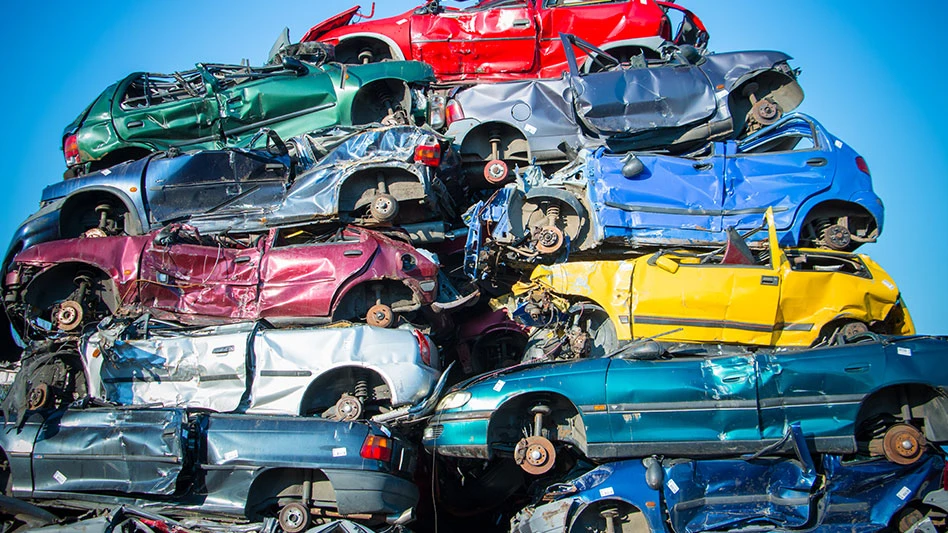Recycling that doesn’t make economic sense just doesn’t make sense. That opinion may not be shared by everyone in the recycling industry, but it probably can be said to speak for many business owners in other industry sectors.
Among construction and demolition contractors, there are certainly some who recycle because they believe it is the right thing to do for the environment. Many others, however, need to see the economic benefits of either reprocessing materials on site or hauling them to a recycling processor.
What can determine the economic viability of recycling construction and demolition (C&D) debris? The first things to be considered are probably the costs incurred by not recycling, and simply hauling debris to the landfill. Transportation costs can vary from job to job, but disposal costs—landfill tipping fees—provide a dollar amount that contractors can quickly determine and can use as a fairly accurate yardstick.
Tipping fees can vary widely from state to state or even within a state (or province). Contractors operating near a state border—or anywhere in the eastern U.S. with smaller states offering proximity to several borders—now may have more disposal options than they had previously. A series of court decisions has upheld the right of landfills to accept waste and debris generated in other states. While these rulings against "flow control" are often watched most closely in the municipal solid waste industry, C&D debris generators have also taken note.
A study of several major metro markets reveals the ways different tipping fee structures affect the local C&D debris recycling markets.
Toronto Choices Include International Shipping
In the C&D debris market, material flows not only across state lines, but also across the U.S.-Canada international border. "A lot of our C&D waste goes south of the border to be land-filled," notes John Hanson, executive director of the Recycling Council of Ontario (RCO), Toronto.
According to Hanson, there are C&D landfills in border states such as New York and Michigan that are charging as little as $15 per ton to accept C&D debris. Even though transportation costs bump that per ton disposal price up, many contractors are still choosing to ship debris across the border.
Despite the competition, there is still some significant C&D debris recycling activity taking place in Ontario, according to Hanson. He notes that concrete and other road surfaces—among the heaviest and costliest materials to haul long distances—are being crushed and re-used frequently. "There’s a lot more of that happening now. The Ministry of Transportation has loosened some past restrictions that discouraged the use of C&D aggregate," says Hanson. "You’re seeing a lot more go into roadbeds and into asphalt as well."
Other C&D materials can also be recycled in metro Toronto, Hanson notes. "There are quite a few places in and around Toronto that accept waste wood, which is processed into a variety of things, such as pressboard, chipboard and fire logs."
New West Gypsum, a Vancouver-based company, also has a facility in Oakville, Ontario. "They would like to have more construction-site gypsum debris for the wallboard operation in Oakville," says Hanson, "but they’re not getting a lot of material because they’re competing with cheap disposal prices."
L.A. Recyclers Strive to Maintain Momentum
California has long been home to many recycling advocates, and several of them are active in the C&D debris markets there. "I would say we’re way ahead in southern California in the area of processing road materials and re-using them as road base or base course," says Kelly Ingalls, a project manager with the City of Los Angeles Integrated Solid Waste Management Office.
Tipping fees in southern California can range below $20 per ton for green waste or C&D debris at landfills specializing in C&D debris, to more than $34 per ton at larger Class III landfills.
While these rates still make disposal an affordable option at many job sites, Ingalls says that due to the extensive recycling infrastructure that exists in southern California, taking source-separated loads in particular to a landfill would be "throwing money down the drain."
Recyclers will charge just $3 to $5 per ton for a load of inert debris such as concrete or asphalt. "The loads they are taking in are, say, a foundation or a street surface. It has to be a clean load," says Ingalls.
And for major road projects, "on-site crushing is done a lot by CalTrans," notes Ingalls. "Any kind of project that has the space and generates in excess of 10,000 tons of concrete, crushing on site can break even," he remarks.
Waste wood is not necessarily waste in southern California, although markets are not as good as they were a few years ago when waste wood was being used by ‘biomass’ consumers who were burning the wood debris as a fuel source. (Subsidies that initially helped establish this market have subsequently been halted.)
But there are still facilities in southern California accepting loads of waste wood for recycling purposes. "It’s very competitive," notes Ingalls. "There are some places charging only about $12 per ton."
Robert Brickner, senior vice president with Gershman, Brickner & Bratton Inc., Fairfax, Va., says entrepreneurs must put the proper forethought into starting up a waste wood recycling operation. "It takes work," he comments. "The main problem with entrepreneurs who are looking to get into it is they are comfortable with the front end," says Brickner. "They know the equipment, but the key is not the front end, it’s solidifying the back end markets for the product."
Street Level Recycling in New York
Big Apple C&D generators have for some time taken advantage of the interstate commerce options offered by the city’s proximity to several other states. "Most private contractors ship the material out of state," says New York City Department of Sanitation spokesperson Paula Young regarding C&D debris.
While such shipping often involves finding the most affordable landfill in a nearby state, a few recyclers have also set up shop in states such as New Jersey.
The city government in New York City has also actively encouraged the scraping and re-processing of paving materials in road projects taking place within the city. "We had almost 500,000 tons of C&D materials reused for road and cover material within the city limits in 1997," says Young.
New York’s attention to road surface recycling is not unique, according to Brickner. "Without a doubt, asphalt and concrete are the number one and two items recycled, because the bulk density is so great," says Brickner. "Plus, it’s already source separated, in effect, especially with road projects. Crushing, screening and reuse is pretty easy."
It remains to be seen how the New York City landfill picture will change if the massive Fresh Kills landfill operated by the municipal government of New York City shuts down in three years as it is scheduled to do. While the greatest impact will be on municipal and commercial solid waste haulers, some ripple effect could also change the rates at destinations currently favored by C&D debris generators.
Windy City has C&D Infrastructure in Place
Along with Pacific Coast metro areas, Chicago has developed one of the more active C&D debris recycling markets. As described in RT earlier this year (Chicago Hope, March 1998, pg. 142), the State of Illinois and several industry trade organizations jointly produced a directory of C&D debris recycling companies, as well as a guide with "how-to" information on C&D debris recycling processes.
While these efforts may have created one of the most organized C&D debris markets, costs and obligations are still driving decisions on how to handle C&D debris. According to Tim Garvey of Brandenburg Demolition in Chicago, decisions on whether or not to take debris to a recycling site or a landfill can depend on which side of town the project site is located. "There are two south side landfills that are reasonable," says Garvey. "But the north side is entirely different. We tend to recycle more up there."
Sponsored Content
Still relying on manual sorters?
Let AI do the heavy lifting. Waste Robotics delivers reliable, high-performance robots tailored for complex waste streams. They require minimal maintenance, are easy to operate, and are designed to boost your recovery rates. Smarter sorting starts with the right partner. Waste Expo Booth #1969 & REMA #2843
Click here to see our robots in action!While the existence of a landfill accepting material for as low as $12 per cubic yard is often the key factor driving a decision, the company also tries to calculate transportation costs when making the decision.
As in other markets, on-site crushing of stone-based materials is also an option for Brandenburg. "We have a concrete crusher. If we have significant enough volume—we often use 20,000 tons as a figure—we do set that up," notes Garvey. "That will go to either side of town," he adds.
Garvey adds that on-site crushing is especially cost-effective when the project manager of a new development is willing to use crushed materials from a building being demolished at the same site. "That can work out well, if it’s a product they can use for their development," he remarks.
Chicago Department of the Environment spokesperson Jessica Rio notes that the most affordable C&D debris landfill operating in Chicago will not be open much longer, perhaps providing further encouragement for a C&D recycling market that is already well established.
Factors Could Affect Future Fees
The factors that helped launch the C&D recycling industry—the environmental movement coupled with a perceived looming landfill shortage—may have reached their maximum point of forward momentum. While some markets and many recycling techniques have been established because of these initial concerns, economic justification will drive any near-term future growth within the C&D debris recycling industry.
The other variable that could spur even more attention to C&D recycling is a sharp increase in tipping fees. But, "landfills right now and for the next few foreseeable years are relatively inexpensive," says Brickner. "There still are some large capacity C&D landfills out there."
Solid waste industry consolidation could help C&D recycling in the near future, as could government-imposed recycling rate goals. "As the waste industry consolidates, we are already seeing some gradual uptick in landfill prices," notes Brickner. "Since they are already low now, however, that trend would probably have to accelerate to make an impact."
State governments paying close attention to their recycling goals may also begin paying more attention to the C&D segment, Brickner believes. The most recent EPA solid waste stream study suggests that C&D debris may make up half of the entire non-industrial solid waste stream. "It’s a significant stream that many municipalities haven’t paid much attention to before," says Brickner. "These municipalities may have a lot of their municipal solid waste contracts in place, now they may start looking at the C&D issue and it will come up on their radar screen. Recycling C&D debris could present an opportunity to meet waste diversion goals."
The author is the editor of Recycling Today.
Get curated news on YOUR industry.
Enter your email to receive our newsletters.

Explore the December 1998 Issue
Check out more from this issue and find your next story to read.
Latest from Recycling Today
- Circular by Shapiro releases "5 for Five" sustainability series
- Graphic Packaging set to close Ohio CRB facility
- Ameripen voices support for Maryland EPR bill
- Matalco to close Canton, Ohio, plant
- Maryland county expands curbside recycling to include electronics
- California EPS ban will be enforced
- YKK AP America introduces BetterBillet
- Fresh Perspective: Cameron Keefe








